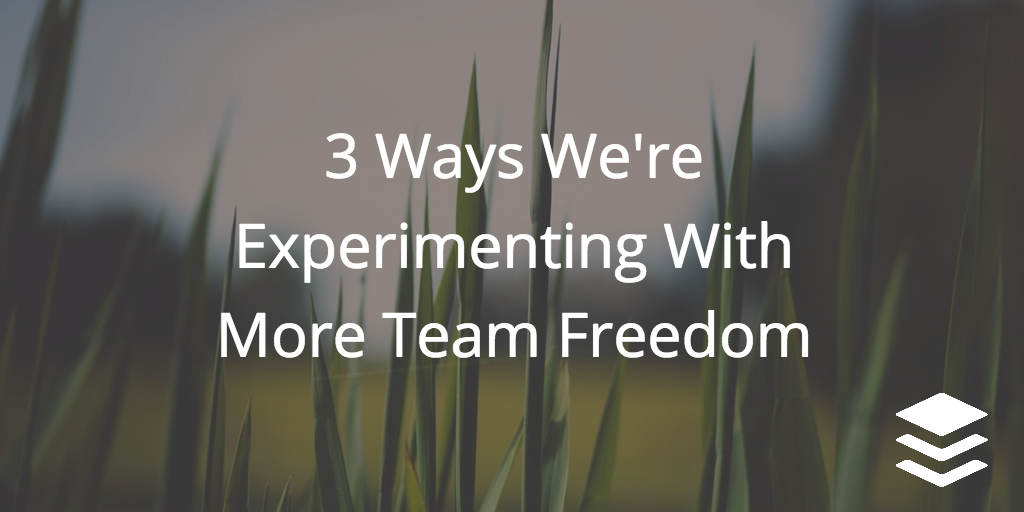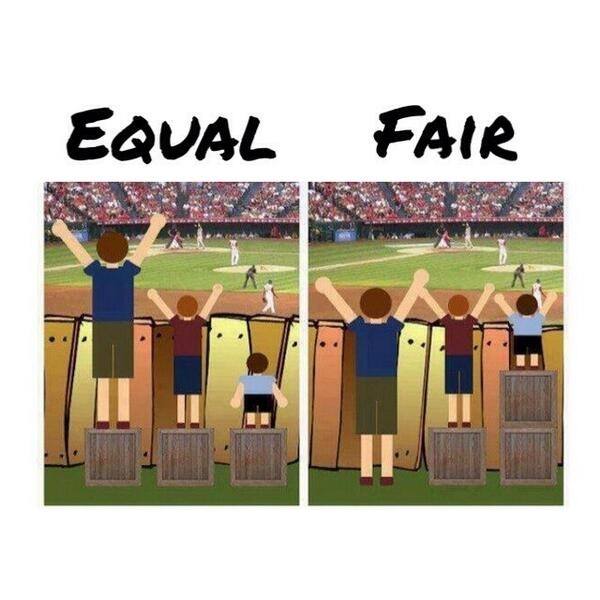I’ve always been a person who follows the rules. No coloring outside the lines. Work within the system.
At times, this has worked out fine. More often, though, I’ve had to work to retrain myself to take bigger risks, speak up more and be less afraid of “getting in trouble.”
Especially at work, rule following can be a bit of a double-edged sword. Getting tough feedback for being out of line or overreaching is hard, but so is missing an opportunity you know you would have rocked.
What if we could create a workplace so light on rules that you always felt freedom to make your own calls?
That’s the idea we’ve been exploring in Buffer’s People Team recently.
People or HR teams often have a reputation for not just following the rules but creating the rules for their companies. As an organization grows, the number of policies and procedures tends to grow alongside the team until there’s a rule for everything – and making an exception takes a lot of work.
That’s not what we want for Buffer as we work toward defining and realizing the future of work. But what’s the alternative?
“If you give people freedom, they will amaze you. They’ll do remarkable things and all you need to do is give them a little infrastructure and a lot of room to change the world.” – Lazlo Bock, Google
“Each of us has to create our own effort, conduct our own experiment, name our own child. We will experience our freedom the moment we take our assignment, our job, and make it our own.” – Peter Block, Stewardship: Choosing Service Over Self-Interest
As an organization, we learned a lot from our previous experiment in self-management. Although I wouldn’t call Buffer self-managed right now, there are some common tenets we seem to return to again and again in slightly different ways: Autonomy paired with accountability. Freedom paired with responsibility.
We have a team of smart and excellent folks, and we’d like to trust them to make great decisions in their areas.
So where does that leave the People Team? We’ve been the “policy-makers” on things like Buffer’s minimum vacation, what elements of the work and personal development experience Buffer will pay for, which holidays the team takes off, and other “rules and regulations” that we have long believed Buffer team members want to give them guidance.
But if we truly want to give the decision-making power to the team, maybe it’s time to dismantle policies, not create more. Here are three ways we’re currently experimenting to give our team more freedom.

1. Decentralizing People power to individual teams
Who would be the best person to decide how our Happiness Team should schedule their time off to make sure customers are taken care of while also preserving the work-life balance of teammates? Probably someone from the Happiness Team!
Who has the most context to figure out the kind of building cycles our product and engineering teams should use to make sure Buffer keeps building the features our customers are looking for? Makes sense that it would be someone on those teams.
Different areas of an organization have their own rhythms, traditions and expectations. I believe this may be especially true on a fully distributed team like Buffer, where culture can disseminate and grow organically in tight pockets of connection.
So why is it the generally accepted model for one person or team to make policies that apply to everyone across the board? Of course we want things to be fair and equal, but fairness and equality aren’t always the same thing, as this great graphic shows.

Source: Craig Froehle
For example, our Happiness team has a constant and unceasing workload as they strive to take care of our customers in a prompt and empathetic manner. I, on the other hand, have no such internal pressures and can spend the day thinking about esoteric concepts like equality and fairness. Both kinds of work are valuable, but they’re not the same. One requires a strict schedule and a large expenditure of empathy, while the other requires philosophical thinking and team research.
It’s because of this type of differentiation that we’re trying a model of decision-making that prioritizes the individual team’s needs over the company as a whole. The Happiness team might need some extra time outside of the inbox to keep growing, while the Engineering team’s biggest challenge might be preventing burnout by working with a “self-care buddy” to turn off at the end of the day. (Both of these are actual current team initiatives!)
In this model, the People team’s role is simply to respond to the needs of each area. We can listen and propose some solutions, we can help implement a solution the team already has in mind, or we can identify any signals we see that might indicate a challenge.
The end product isn’t policies but custom solutions and resources to help each team actualize their best working environment.

2. Exploring the concierge model
Going from the team level to the individual teammate level, the “concierge model” is what we’ve been experimenting with most recently on the People team. We can try to diagnose some of the common things we think might make our team happier, but they’ll never apply equally to all people – a change that’s ideal for one person might be unnecessary or even annoying for another.
Enter the concierge model. A great hotel concierge is worth their weight in gold. Just say the word and they can get you into that trendy restaurant or grab you tickets for that hot show. But they don’t do any of that until you ask. They don’t burst into your hotel room in the morning with your itinerary. You have to ask first.
Teammates are often looking to get guidance in specific areas or aspects of their role, like:
- How can I have better one-on-one meetings?
- How can I learn to code while in my current role?
- How do I hold a skip-level meeting?
- How do I manage someone who’s also a manager?
In any of these cases and many more, teammates can enlist the People Team’s help, and we’ll pull all the best research we can find on their topic and present it in a one-on-one chat tailored to that teammate’s preferred learning style. We’ll also add it to a pooled resource available to anyone on the team to view and use at any time.
In this model, we believe team members can get the specific resources they’re looking for without having to spend time outside their role doing research. They can then apply any or all of the elements that make the most sense to them, or keep talking with the team to create a personal development plan. The People Team doesn’t create new policies, it simply researches and shares resources and best practices.
We’ve tried this out with a few teammates so far to pretty great results!

3. From push to pull info
At Buffer we’ve long prized a bias toward action, which means all our teammates are excited to DO things. Make things, fix things, ship things. Produce. Generally, this is an awesome mindset that means we get lots done for our audience and customers, and that’s a great feeling for everyone involved!
On the People team, however, this has sometimes meant we have a tendency to flood our team with…stuff. We want to find out how they’re feeling, do things for them and then tell them what we did. So we share surveys, new documents, announcements and more. And although this urge come from a positive place, all this stuff can end up having the opposite effect: It might actually be contributing to the team’s stress level.
Even when it’s good stuff to read, like announcing new learning and development stipend, the announcement can still feel like more mental weight if it comes at the wrong moment in someone’s day. Stuff to do, like take a team-wide survey, can feel similarly stressful when surveys are too frequent or too time-consuming.
So our last experiment might seem a bit obvious, but it’s actually quite radical for Buffer. :) We’re attempting to move from a “push” structure, where every new policy or change requires an announcement, to a “pull” structure, where instead teammates are equipped with the right resources in a reliable, expected place so they can get the information they’re looking for when they need it.
To get there, we’re doing simple but meaningful things like building out a true company handbook (we’re excited to share it with you soon!), merging competing resources to make sure there’s “one source of truth” for any topic, and cleaning up our processes for our main communication tools like Slack, Paper and Discourse.
It’s deeply unglamorous work. It feels pretty boring to even blog about it. There is no big thrill of shipping in a process like this, but there is the hope that our teammates will soon have a better experience every day at work (even if they can’t quite put their finger on exactly why). And that’s pretty thrilling, actually.
The big caveats of this experiment
Some of these tactics are a bit of a departure from the last year at Buffer, where we’ve strived to make culture and policies more explicit so our teammates never have to guess what’s expected of them.
We’ve talked a lot about ask culture vs. guess culture and strived to move further toward the “ask” end of the spectrum. This includes breaking through artificial harmony and being willing to say what’s on your mind, even when it might be tough or divisive.
As long as we keep working toward these goals, I think these tactics will benefit our team. There are, though, a few challenges and risks that I want to be on the lookout for as we move forward.
- “Squeaky wheel” syndrome: The concierge model relies on teammates to speak up proactively about what they need and where they might have challenges. Not everyone feels equally comfortable bringing these things up with their lead or with members of the People team (particularly if they are more aligned with the “guess culture” style.) We’ll need to be on the lookout for disparities this might create, and to put into place extremely lightweight ways to reach out.
- Lack of clarity: “Communicate with clarity” is one of our core values at Buffer, and many teammates have expressed appreciation for the clarity that policies like moving from unlimited vacation to a minimum vacation expectation have created. There’s a chance that relying more on team-based and individual decision-making could renew a feeling of lack of clarity, or create a situation where teammates are spending a lot of brainpower and emotional bandwidth trying to glean what’s expected of them.
- Feeling of inequality/unfairness: The nuances between equal and fair can potentially be a bit tricky, both to understand and to agree upon. If different teams begin to diverge in unique ways, with their own individual interpretation of culture, their own perks and their own “policies” (or lack thereof), will some areas of Buffer start to feel unequal?
- Transparency: Another of our core values is transparency, which is perhaps why we’ve focused so much on public announcements of cultural initiatives and policies in the past. Moving from “push” to “pull” in our communication could mean that transparency looks and feels a bit different. If the information is still available but you have to look for it, do we still meet our value of “default to transparency?”

Over to you!
I’m keen to share more on these tactics and overall philosophy as we keep going. Meanwhile, I’d love to hear your thoughts on any of this!
- How do you offer freedom without creating confusion along with it?
- How do these tactics feel to you, and are there challenges or benefits I’m not thinking of?
Let me hear everything in the comments!
Try Buffer for free
190,000+ creators, small businesses, and marketers use Buffer to grow their audiences every month.




